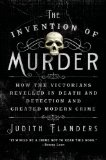Summary | Excerpt | Reviews | Beyond the book | Read-Alikes | Genres & Themes | Author Bio

How the Victorians Revelled in Death and Detection and Created Modern Crime
by Judith FlandersThe subtitle says it all: "How The Victorians Revelled In Death And Detection And Created Modern Crime."
And if that gives one a start of surprise, well it should. When we hear that "V word," we are more apt to think of overly ornate boudoirs, tight corsets, yards of silken brocade, and the romantic language of the fan. But murder? Oh, certainly we've all heard of Jack the Ripper and 125 years later are still fascinated by him (or her?). But that was an anomaly of the era – wasn't it?
Social historian Judith Flanders proves herself a master storyteller as she recounts copious tales of British murder and mayhem that course through the entire 19th century and deftly shows us how our Victorian forebears were as fascinated by the subject as any devotee of reality television is in our own day.
Otherwise perfectly respectable pillars of Victorian society crowded into courtrooms, traipsed through still gory crime scenes, and greedily devoured sensational newspaper accounts (factual or not—mostly not). They also spent their hard-earned shillings on various broadsides, penny dreadfuls and theatrical efforts that materialized before the bodies in question were barely cold. Imagine, if you can, trying to resist the lure of a marquee on a fashionable West End theatre boldly proclaiming "JONATHAN BRADFORD, OR THE MURDER AT THE ROADSIDE INN." This evil innkeeper melodrama premiered in 1847 and ran for 161 consecutive performances (including Sundays), an astounding record for the time.
Furthermore, and this might be the real surprise here, many of these same paragons shelled out large sums for the best seats at the executions before such spectacles were removed from the public eye in 1868. Those who lived in close proximity to the gallows also proved extremely enterprising by charging exorbitant prices for the best views from their front windows or rooftops!
 Although, as Flanders hastens to point out, murder in the 19th century was relatively rare, the sensationalizing of it was not — even if we think the phrase, "If it bleeds, it leads" is a more contemporary invention. Buttressed by a cast of characters that is by turns colorful, gruesome, pathetic and fascinating, Flanders writes history at its most readable that flows along like an exciting novel and arrives at some eye-opening conclusions, namely how this penchant gave rise, not only to the creation of the modern police force as we know it, but also one of the most popular literary genres ever created: detective and mystery fiction.
Although, as Flanders hastens to point out, murder in the 19th century was relatively rare, the sensationalizing of it was not — even if we think the phrase, "If it bleeds, it leads" is a more contemporary invention. Buttressed by a cast of characters that is by turns colorful, gruesome, pathetic and fascinating, Flanders writes history at its most readable that flows along like an exciting novel and arrives at some eye-opening conclusions, namely how this penchant gave rise, not only to the creation of the modern police force as we know it, but also one of the most popular literary genres ever created: detective and mystery fiction.
For example, take the case of the notorious Road Murder, June 28, 1860. A respectable Wiltshire household awakens to find its toddler son, little Francis Savile Kent, unaccountably missing. Accordingly, the four older children of Samuel Kent by his first wife (the current Mrs. Kent being too pregnant to assist), the servants, and the nearby townspeople as well as a contingent of the Trowbridge constabulary meticulously search house and grounds to no avail. Finally as afternoon begins to crawl toward evening, the toddler's body is discovered, thrust down an outside privy, his throat cut and a stab wound to the chest.
Whodunit? A jealous stepchild? A disgruntled servant? A neighbor with a grudge? Or perhaps (Oh, horrors!) a roving band of gypsies. Rest assured, all is divulged and expounded in this spellbinding account of this foul deed—and many more besides.
And what about "…our own lighthearted friend, Yours truly, Jack the Ripper?" He appears here, too, although not until the final chapter, and not before we have already been treated to a host of dismembered fiancées, poisoned spouses, blood-spattered shopkeepers, smarmy body snatchers and sadistic butchers a la the fictional Sweeney Todd, The Demon Barber of Fleet Street.
It is not often that history can be described by the words "a page-turner," or "I couldn't put it down," but Judith Flanders succeeds on both levels. She provides an intriguing slant on an era about which there are many myths and misconceptions and shows us only too well that we are not so far removed from our ancestors after all.
Picture of Penny Dreadful from CollectingBooksandMagazines.com
![]() This review was originally published in The BookBrowse Review in September 2013, and has been updated for the
August 2014 edition.
Click here to go to this issue.
This review was originally published in The BookBrowse Review in September 2013, and has been updated for the
August 2014 edition.
Click here to go to this issue.

If you liked The Invention of Murder, try these:

The Dead Duke, His Secret Wife, and the Missing Corpse
by Piu Marie Eatwell
Published 2016
One of the most notorious and bizarre mysteries of the Edwardian age, for readers who loved The Suspicions of Mr. Whicher

by Stephen Jarvis
Published 2016
A vast, richly imagined, Dickensian work about the rough-and-tumble world that produced an author who defined an age. Few novels deserve to be called magnificent. Death and Mr. Pickwick is one of them.
Your guide toexceptional books
BookBrowse seeks out and recommends the best in contemporary fiction and nonfiction—books that not only engage and entertain but also deepen our understanding of ourselves and the world around us.